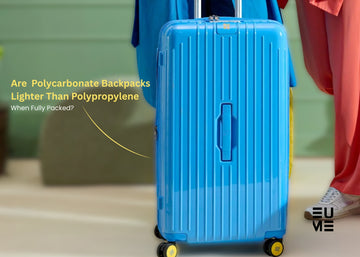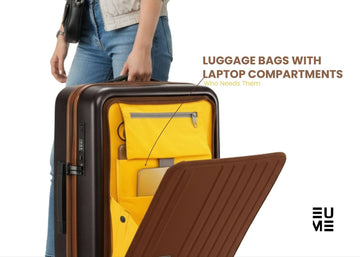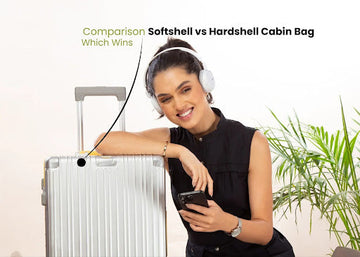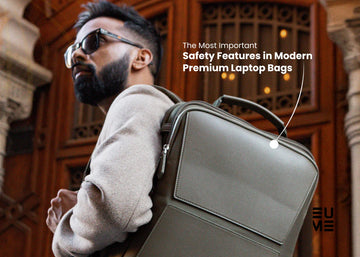What Makes a Backpack Truly Lightweight?
Packing for a trip often begins with an important question: how can you make your bag as light as possible without sacrificing what you need to carry? Many travellers overlook the role of the luggage material, assuming the lightest shell automatically means the lightest overall weight. What really matters is how that material performs once the bag is full.
Weight limits at airports have grown stricter, making lightweight travel bags essential for regular flyers. Travellers are looking for bags that make moving through airports smooth and effortless.
Choosing the right travel backpack helps reduce fatigue, avoid excess baggage fees, and make every journey feel less like a workout and more like a smooth transition.
Breaking Down the Two Most Popular Materials
Understanding how polycarbonate backpacks and polypropylene bags behave is the starting point for making a smart decision.
|
Feature |
Polycarbonate Backpack |
Polypropylene Bag |
|
Weight (empty) |
Moderate |
Lightest of the two |
|
Durability |
High impact resistance |
Flexible but less impact-proof |
|
Surface |
Glossy, premium finish |
Matte, simple finish |
|
Flexibility |
More rigid |
Flexible, compresses easily |
|
Cost |
Usually higher |
More budget-friendly |
Polycarbonate Backpack: Strong and Protective
-
Known for impact resistance and structural strength.
-
Ideal for checked-in luggage or rugged travel.
-
Offers a polished, premium exterior that resists dents and cracks.
Polypropylene Bag: Flexible and Feather-Light
-
Recognised for its low density, making it the lightest luggage material.
-
Compressible and easier to store in tight spaces.
-
Less impact resistance than polycarbonate, but ideal for short trips.
How Much Does Material Weight Actually Matter?
The difference in base weight between these two materials is clear, but what happens when the bag is fully packed? Most cabin-size bags carry between 7 and 10 kg on average. A typical polycarbonate backpack weighs around 2.8 kg when empty, while a polypropylene bag can weigh about 2.3 kg. That half-kilo difference matters to some travellers, but once you’ve packed your clothes, shoes, and gadgets, the weight of the material itself becomes far less significant.
Smart packing habits often outweigh material differences. Travellers who pack thoughtfully can make a slightly heavier polycarbonate bag feel just as manageable as a lighter polypropylene one.
Packing Strategy Can Make or Break Lightweight Travel
Even the lightest bag can feel like a burden if it’s poorly packed. A structured packing strategy reduces the total weight you feel on your shoulders or in your hand. Some smart packing habits can make a major difference:
-
Place heavier items near the base of the polycarbonate backpack or polypropylene bag to distribute weight evenly.
-
Use packing cubes to compress clothes and reduce air gaps inside the bag.
-
Roll clothes instead of folding them to save space and minimise creasing.
-
Limit duplicate items to cut down on unnecessary weight.
-
Pack multi-purpose pieces that can be worn or used in different ways.
Efficient packing habits give you more control over how your bag feels once it’s full, regardless of the shell material.
Why Travellers Still Choose Polycarbonate Backpacks
There’s a reason many seasoned travellers continue to prefer a polycarbonate backpack even when weight is a concern. The structured shell provides peace of mind when checking in luggage, and the sleek exterior stands up well against rough handling.
People who fly internationally or frequently often value durability over shaving off a few hundred grams. For these travellers, a slightly heavier shell is a small price to pay for strength and protection.
Why Polypropylene Bags Are a Go-To for Light Travellers
For weekend getaways or domestic flights, many travellers lean towards a polypropylene bag. Its lightweight structure is easy to manoeuvre, and the flexible shell makes it simple to store or tuck into a crowded cabin bin.
It’s a popular pick for anyone who wants to move quickly, pack light, and avoid the hassle of checked-in baggage. It’s also a cost-effective choice, which makes it appealing to frequent travellers who don’t need a highly structured shell.
Weight vs Functionality: The Real Travel Equation
The lightest option on paper isn’t always the lightest option in real life. What matters is the balance between the base shell and how efficiently the interior is used.
-
A polycarbonate backpack gives structure, strength, and a polished exterior.
-
A polypropylene bag offers flexibility, lighter base weight, and easy storage.
-
Smart packing and internal organisation are what actually determine how heavy the bag feels.
Travellers who focus on smart interior layout often enjoy a more comfortable travel experience regardless of the shell material.
How Eume Designs for Real Lightweight Travel
Eume builds travel solutions with a clear focus on function and mobility. Every lightweight travel bag is created with the modern traveller in mind. Instead of simply focusing on the shell, the design integrates features that make every gram count.
-
Smart compartments help avoid wasted space.
-
Lightweight but durable shells support long-term use.
-
A clean structure makes it easier to organise essentials.
-
Balanced weight distribution reduces strain during movement.
The idea is simple: travel should feel effortless, not weighed down.
Final Word: It’s Not Just About the Shell
A polypropylene bag is technically lighter than a polycarbonate backpack, but the total packed weight depends far more on what’s inside than what’s on the outside. For rugged travellers, polycarbonate still wins for durability. For ultra-light packers, polypropylene is the better pick.
Whichever option you choose, a thoughtful approach to packing and design matters more than shaving off a few grams of shell weight.
Browse the Eume backpack collection and see how intelligent design can make lightweight travel feel easier than ever.
FAQs
1. Which is lighter, a polycarbonate or a polypropylene backpack?
A polypropylene bag is generally lighter than a polycarbonate backpack, but once packed, the difference is often minimal.
2. Does the material affect the weight when the bag is full?
The shell affects weight slightly, but most of the total comes from the contents inside.
3. Are polycarbonate bags easier to carry for long journeys?
Yes, many travellers prefer a polycarbonate backpack for its structured support and reliable durability during extended trips.
4. Do polypropylene backpacks compress better for storage?
Yes, a polypropylene bag is flexible, making it easier to store in smaller spaces.
5. Which Indian brands make lightweight travel backpacks?
Several brands, including Eume, design lightweight travel bags that focus on both comfort and function.






















